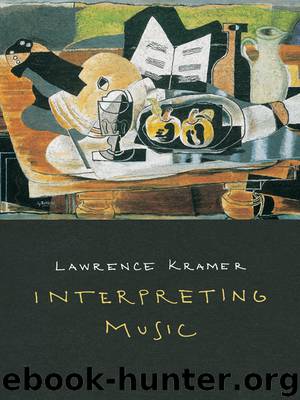Interpreting Music by Kramer Lawrence

Author:Kramer, Lawrence [Kramer, Lawrence]
Language: eng
Format: epub
ISBN: 978-0-520-94736-8
Publisher: University of California Press
Published: 2011-03-14T16:00:00+00:00
4.
If we step back now and reflect on this interpretation, its pattern runs something like this. An analytic description evolved into an account of musical self-division for which the reasons were historical and cultural. In the process of supporting the account, the reasons given also modified and enriched it, exposing not only a matter of concern common to Beethoven and Kant but also a bone of contention between them. The analysis told us something about the world by encouraging the world to tell us something about the analysis. This procedure, moreover—and the point can’t be stressed too much—is completely reversible. We could have formed a cultural-historical interpretation involving noncontradictory self-division and found reasons for it in the analytic account of Beethoven’s Largo, reasons that would have enhanced the interpretive claim in the act of supporting it. We might, for example, have suggested on the basis of the music that the demand for conformity paradoxically heightens the reflexive awareness that resists conformity. At any rate we would have been able to reach conclusions that would overlap, if not altogether coincide.
We might also have reached similar conclusions for different analytic reasons, for example by attending to the pervasive but unstable division of labor that allots melody primarily to the strings and texture to the piano. Or we might have preferred one analysis over another for hermeneutic reasons. A Schenkerian approach might understand the apparent C major of the “Ghost” Largo as simply an extended dominant of F, a role suggested at the very outset of the movement.13 The “key” would thus reduce to a subsidiary element in the composing out of the D-minor triad across the span of the exposition. Yet there might well be cause to question such an analysis, not on technical grounds but on cultural and semantic ones. C major as a robust phenomenon entangled with D minor comports well with the culture of split and doubled subjectivity contemporary with the “Ghost” Trio; C major as a placeholder for F does not.
Within that frame of reference the sheer phenomenal weight of C-major sonority might be heard to resist any subordination to an underlying structural process. It might even be heard to throw the credibility of such a process into doubt; it would dare to know in another fashion. The reasons for the music’s giving C major, or “C major,” such interrogatory force, for making it such a prominent smear across the pristine surface of D minor, are impossible to contain within the boundaries of the analytical system. The moment this sort of questioning arises, the moment the analytical discourse becomes self-reflective rather than self-sufficient, the worldly dimension of the music is already fully activated. The question is not how to find the enlightened subject in the “Ghost” Largo, but why anyone imagines it could be kept out.
Download
This site does not store any files on its server. We only index and link to content provided by other sites. Please contact the content providers to delete copyright contents if any and email us, we'll remove relevant links or contents immediately.
| Biographies | Business |
| History & Criticism | Instruments |
| Musical Genres | Recording & Sound |
| Reference | Songbooks |
| Theory, Composition & Performance |
The Goal (Off-Campus #4) by Elle Kennedy(13161)
Kathy Andrews Collection by Kathy Andrews(11276)
Diary of a Player by Brad Paisley(7233)
What Does This Button Do? by Bruce Dickinson(5914)
Assassin’s Fate by Robin Hobb(5818)
Big Little Lies by Liane Moriarty(5486)
Altered Sensations by David Pantalony(4831)
Pale Blue Dot by Carl Sagan(4573)
Sticky Fingers by Joe Hagan(3884)
The Death of the Heart by Elizabeth Bowen(3311)
The Heroin Diaries by Nikki Sixx(3291)
Beneath These Shadows by Meghan March(3115)
Confessions of a Video Vixen by Karrine Steffans(3083)
The Help by Kathryn Stockett(2995)
How Music Works by David Byrne(2932)
Jam by Jam (epub)(2859)
Harry Potter 4 - Harry Potter and The Goblet of Fire by J.K.Rowling(2777)
Strange Fascination: David Bowie: The Definitive Story by David Buckley(2687)
Petty: The Biography by Warren Zanes(2557)
